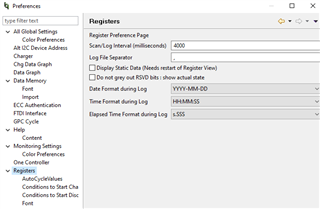Other Parts Discussed in Thread: BQSTUDIO
Tool/software:
BQ40Z50-R2 Communication Issue
When communication is unavailable, the delay time for the protection point increases.
How can I resolve this issue?
This thread has been locked.
If you have a related question, please click the "Ask a related question" button in the top right corner. The newly created question will be automatically linked to this question.
Tool/software:
BQ40Z50-R2 Communication Issue
When communication is unavailable, the delay time for the protection point increases.
How can I resolve this issue?
Hello, Anthony.
When I disconnect the communication, the COV delay time is no longer within the set range (delay set at 2 seconds, activates after 7 seconds). Additionally, it may require a higher voltage to activate (COV set at 4.25V, actually activates at 4.29V).
You can use an EVM board to verify this issue.
Hi Wayne,
The sleep voltage time is counted using an internal counter within the gauge, to which I do not believe that removing communication would affect the counting. Has it been observed that when communication is available, the delay time for the COV protection is accurate?
Regards,
Anthony Baldino
Hi Wayne,
I see that even while communication is running, it is still greater then the delay. Would it be possible to run this test again while having the bqStudio log on, with a sampling rate of 1s (how to change this can be found on the preferences page below)? This would allow us to see how the gauge is processing this protection when triggered.

Regards,
Anthony Baldino

Hi Anthony
This is a 1-second sampling rate. Do you have any other questions?
I don't understand why adjusting the sampling rate affects the Coefficient of Variation (COV). Please explain and give examples.
I am asking for the second time, have you verified it using the EVM board? Or do you not have an EVM board to verify?
Please explain the method of calculating time in sleep mode.
Regards,
Wayne
Hi Wayne,
This is a 1-second sampling rate. Do you have any other questions?
I don't understand why adjusting the sampling rate affects the Coefficient of Variation (COV). Please explain and give examples.
The changing of the sampling rate will not affect the current results, however when the log file is created it will give more resolution of what is going on within the gauge at this time. Since the default timing is 4s, it would be more difficult to truly determine what is going on within the gauge when the protection is triggered.
I am asking for the second time, have you verified it using the EVM board? Or do you not have an EVM board to verify?
I will look into verifying this on the EVM.
Please explain the method of calculating time in sleep mode.
The time in sleep is calculated using a internal firmware counter, that will wake the gauge up to sample voltage every period determined by the value inputted for the Voltage Time parameter. Has it been observed in your test that altering this value changes the amount of delay?
Regards,
Anthony Baldino
Hi Wayne,
What is the current reading during this time? If you are trying to exit sleep, the gauge relies on the current reading to break the Sleep Current threshold. The Voltage Time dictates the sampling time between voltage measurements while the gauge is in sleep.
Regards,
Anthony
The sleep voltage time setting is 1 second, and the protection is triggered in 6 seconds.
COV delay time is set to 2 seconds (range is 2~5 seconds), so 6 seconds exceeds the intended range.
When a customer uses the product, there is current consumption, and even without communication, there is enough current to break sleep mode.
Hi Wayne,
After receiving council from our team regarding this issue, firmware protections measure in intervals of one second, which in turn will add roughly another second to the trigger time of the protection. In the situation above where the gauge is starting in sleep, the device is required to wake up from sleep and enter normal mode at this time, then sample for the protection, hence why there is more time added to the delay.
More information regarding this can be found in the FAQ below:
Regards,
Anthony